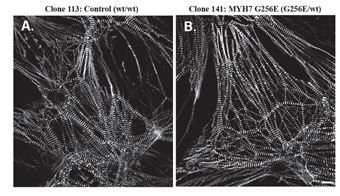 |
| Live imaging of cardiomyocytes from the new cardiomyopathy collection. The cell on the right has a mutation in the MYH7 gene, vital for the formation of heart muscle fibers. This mutation is tagged with a fluorescent protein that illuminates the structures that drive heart contractions. |
The Allen Cell Collection, housed and distributed from the Coriell Institute for Medical Research, addedits first collection of disease-specific induced pluripotent stem cells this week.
Most of these new lines include individual genetic mutations correlated to hypertrophic cardiomyopathy (or HCM), a common and sometimes lethal heart disease, but others represent mutations associated with skeletal myopathy and laminopathy. Each new line is paired with isogenic variants that can accurately replicate the diverse phenotypic outcomes resulting from the mutations.
From these new cell lines representing mutations associated with HCM, researchers can grow heart cells in the lab which allows them to study living material with these known genetic variations.
The Allen Cell Collection was first launched with Coriell in 2016 to provide scientists with state-of-the-art stem cell lines, allowing them to observe the live function of cells with unprecedented clarity. Since its inception, the collection has grown to include dozens of cell lines, each with individual proteins tagged for observation.
Read more about these cell lines from the Allen Institute for Cell Science.